Explore Paris’ medieval heart with this free self-guided Marais walking tour, featuring this picturesque district’s mansion houses, museums and monumental gardens – with map and directions included.
* This site contains affiliate links, where I get a small commission from purchases at no extra cost to you.
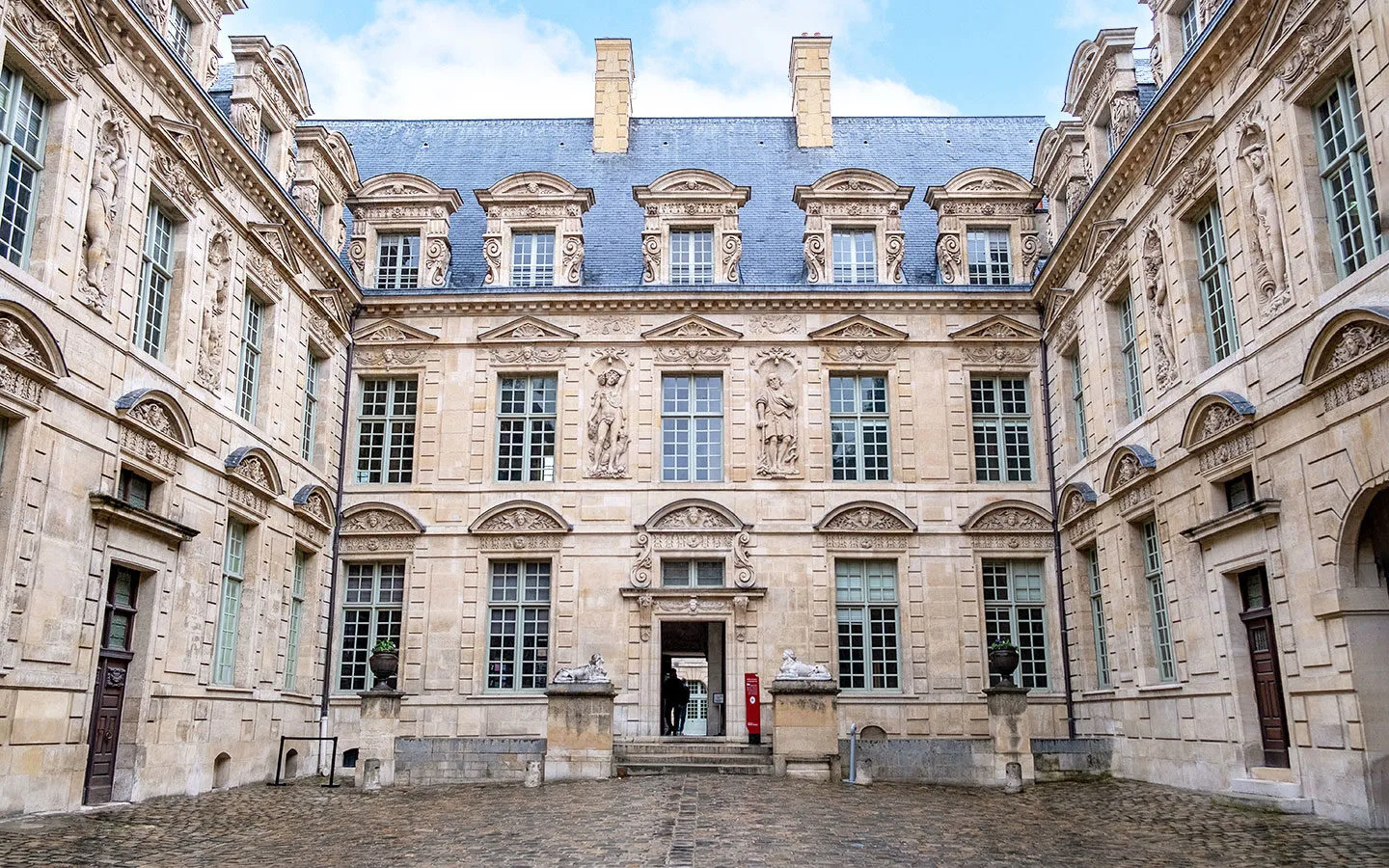
Go back in time with a tour of the Marais, Paris’ medieval quarter. Its name means ‘marsh’ and the area was originally swampland. It became a fashionable residence for royalty and 17th-century aristocrats, but fell out of favour after the French Revolution. Today it’s been restored and gentrified, and has strong Jewish and LGBTQ+ communities.
The Marais mainly escaped Baron Haussman’s modernisation of Paris in the 19th century, so has a different feel to a lot of the city, with narrow cobbled streets, elegant squares and mansion houses. It’s also home to some of Paris’ best museums and galleries. So join us on a self-guided Marais walking tour to discover the area’s historic highlights.
A self-guided walking tour of the Marais

Start your Marais walking tour outside Paris’ Hôtel de Ville. The closest Métro station is Hôtel de Ville (Lines 1 and 11) in the square in front of the building. It’s also less than 10 minutes’ walk from Cité (Line 4) and Châtelet (Lines, 1, 4 7, 11 and 14) stations.
Hôtel de Ville
The Hôtel de Ville is Paris’ city hall and the mayor’s official residence. It was built between 1533 and 1628, and has survived wars, riots and being burnt to the ground by the revolutionary Paris Commune in 1871. It took 19 years to rebuild after the fire, with the exteriors recreating the original design and new, lavish ceremonial rooms inside.
The square in front of the Hôtel de Ville was once used for public executions, with a guillotine set up here during the French Revolution. But today it’s used for less gory public activities, like a festive market at Christmas and a big screen for sports events.

Walk around the back of the Hôtel de Ville, following Rue de Rivoli past the BHV Marais department store. Turn right down Rue de Lobau then left along Place Saint-Gervais. Follow the road to the left of Saint-Gervais church down Rue François Miron.
Rue François Miron
Rue François Miron is one of the oldest streets in Paris, with two medieval half-timbered buildings on the left. The Maison du Faucheur and Maison du Mouton (House of the Reaper and House of Sheep) are named after the occupations of the people who lived there. It’s thought they were built in the 14th century, with the upper floors added later.
In 1607 the façades were covered with plaster to reduce the risk of fire, and were only uncovered in 1967. Many buildings from this period were destroyed during Baron Haussman’s 19th-century redevelopment of Paris, so these two are quite rare.

Turn right at the crossroads following Rue de Jouey, then take the second right down Rue du Figuier and walk as far as the Hôtel de Sens at the end of the street.
Hôtel de Sens and Bibliothèque Forney
With its golden stone archways and turrets, Hôtel de Sens looks like a fairytale castle tucked away in a quiet street in the Marais. It was built in the 15th century for Tristan de Salazar, the Archbishop of Sens, though he died before it was completed.
Look carefully and you can see a cannonball embedded above the entrance, with the date 28 July 1830 below it – dating back to the French Revolution. The Hôtel was later used as a factory and warehouse until the City of Paris took it over and restored it. It’s now home to the Forney Library, with a collection of books on decorative arts and a pretty garden.

Carry straight on, passing Square Marie-Trintignant (where there’s a free public toilet) on your right, then turn left down Rue des Jardins Saint-Paul. Through the archways on your right is the Village Saint-Paul, a collection of art, antique and gift shops set around cobbled courtyards – with a couple of cafés if you want to stop for a drink.
Wall of Philip II Augustus
Between 1190 and 1213, French King Philip Augustus built a great wall around the edge of Paris to protect the city while he was away on the Crusades. Once it was finished it ran for over 5km, stood six to eight metres tall and was three metres thick at the base.
The last of the wall’s gates were knocked down in the 1680s. And although most of the sections of wall left behind have been incorporated into buildings, you can see one of the longest stretches of it on your left, at the end of Rue des Jardins Saint-Paul.

Turn left down Rue Charlemagne then right down narrow Rue du Prévot, which joins onto Rue de Rivoli. Go right and you’ll see a church to your right.
Église Saint-Paul-Saint-Louis
The Church of Saint-Paul-Saint-Louis was the first Baroque church built in Paris, in a change to the usual Gothic style. It was built in 1627 for the Jesuits on the orders of Louis XIII, and was inaugurated by Cardinal Richelieu. But after the Jesuits were banished in 1762 it was used as a warehouse before being restored and used for services again.
Author Victor Hugo’s daughter Leopoldine got married here in 1843, and he donated two fonts to mark the occasion which you can still see today. And when he wrote Les Misérables, he included it as the church where Cosette and Marius get married.

Continue along the main road, which becomes the Rue Saint-Antoine. Then go through the arched doorway on your left which is marked ‘Hôtel de Sully’.
Hôtel de Sully
The Hôtel de Sully is another of the Marais’ impressive mansion houses. It was built in the 17th century for Maximilien de Béthune, Duke of Sully and close friend of King Henri IV. It’s now the headquarters of the Centre des Monuments Nationaux, who manage France’s historic monuments. And although the building isn’t open to the public, you can walk through its courtyards and admire the beautiful façades and courtyard garden.

Walk through the doorway in the far right corner which leads into the Place des Vosges.
Place des Vosges
The Place des Vosges is the oldest planned square in Paris, a perfectly symmetrical space set around a central garden. It was originally known as the Place Royale and was a fashionable place for the nobility to live in the 17th–18th centuries, with its red brick buildings contrasting with the medieval architecture of the Marais.
Former residents include Cardinal Richelieu and Victor Hugo, whose old house in the corner of the square is now the Maison de Victor Hugo museum (free entry, closed Mondays). And underneath the vaulted arches around the square are high-end antique shops, art galleries and cafés where you can stop for a coffee or a glass of wine.

At the opposite side of the square from where you entered it, walk to the west along Rue des Francs Bourgeois and you’ll see the Musée Carnavalet to your right.
Musée Carnavalet
The Musée Carnavalet takes you through the history of Paris, from prehistory to the present day (free entry, closed Mondays). Baron Haussmann had the idea for the museum in 1866, and stored objects and documents at the Hôtel de Ville while the museum was being built – which didn’t work out too well as his collection was destroyed in the 1871 fire.
It’s been rebuilt since, and the museum is now spread across two mansions. There are recreated rooms from different periods in Paris’ history, furniture, paintings and objects including the Hôtel de Ville’s original charred door and a chunk of the Bastille.

From the museum, carry on along Rue des Francs Bourgeois as far as Rue Pavée.
At this point you can take a short diversion to visit the Musée Cognacq–Jay (for 18th-century art and sculpture) or Musée Picasso. Go straight on at the junction and turn right up Rue Elzevir for the Musée Cognacq–Jay. Or walk past that museum and carry on along the Rue de Thorigny for the Musée Picasso.
Otherwise turn left down Rue Pavée, passing La Mouette Rieuse bookshop and café which does a great hot chocolate. Then turn right down the Rue des Rosiers. Look out for the entrance to the Jardin des Rosiers Joseph Migneret on your right, a tranquil community garden. Turn right at the end of the street then left onto Rue des Blancs Manteaux.
Église Notre-Dame des Blancs Manteaux
Go through an unassuming doorway on your left into the Catholic Church of Notre-Dame des Blancs Manteaux (named after the white mantles worn by the monks who founded the original church in 1258). The current Baroque church was built in the 1680s, and has an ornate Bavarian wooden pulpit and 17th-century paintings and sculptures.

Then go straight on and you’ll see the entrance to the National Archives on your right.
Archives Nationales
France has one of the oldest and biggest National Archives in the world. And the documents collected from before the French Revolution are held in two mansions in the Marais – the Hôtel de Soubise and Hôtel de Rohan – which are surrounded by gardens.
The Hôtel de Soubise is where you find the Musée des Archives Nationales (free entry, closed Tuesday). It displays a mix of exhibits from the archive’s collection, which goes all the way back to the first century AD. You can also see the ornate Rococo interiors.

Carry straight on across the junction onto Rue Rambuteau. When you reach a major junction with Rue Beaubourg, the Pompidou Centre will be in front of you. If you do a small diversion to the right here down Impasse Berthaud you can visit the Jardin Anne Frank, a lovely memorial garden with benches and a childrens’ play area.
Centre Pompidou
The Centre National d’Art et de Culture Georges-Pompidou (aka the Pompidou Centre) is instantly recognisable for its quirky, inside-out architecture, with colourful pipes and escalators outside the building. It was designed by architects Richard Rogers and Renzo Piano and opened in 1977 – taking its name from the president who commissioned it.
Inside there’s the largest collection of modern and contemporary art in Europe, as well as a public library and exhibition space. There is an entry fee for the museum, but it’s free to climb up to the top floor where you get fantastic views out across Paris.
Walk around the side of the Pompidou Centre and finish your Marais walking tour by the colourful Stravinsky Fountain. The nearest Métro station is Rambuteau (Line 11), on the corner of Rue Rambuteau and Rue Beaubourg. Or it’s just a few minutes’ walk along Rue du Renard back to the Hôtel de Ville and its Métro station (Lines 1 and 11).

Self-guided Marais walking tour map
If you’d like to do this Marais walk yourself, click on the map below to access directions through Google maps. The route is around 3.8km (2.4 miles) and takes around an hour to walk straight through, but allow several hours to include stops along the way.
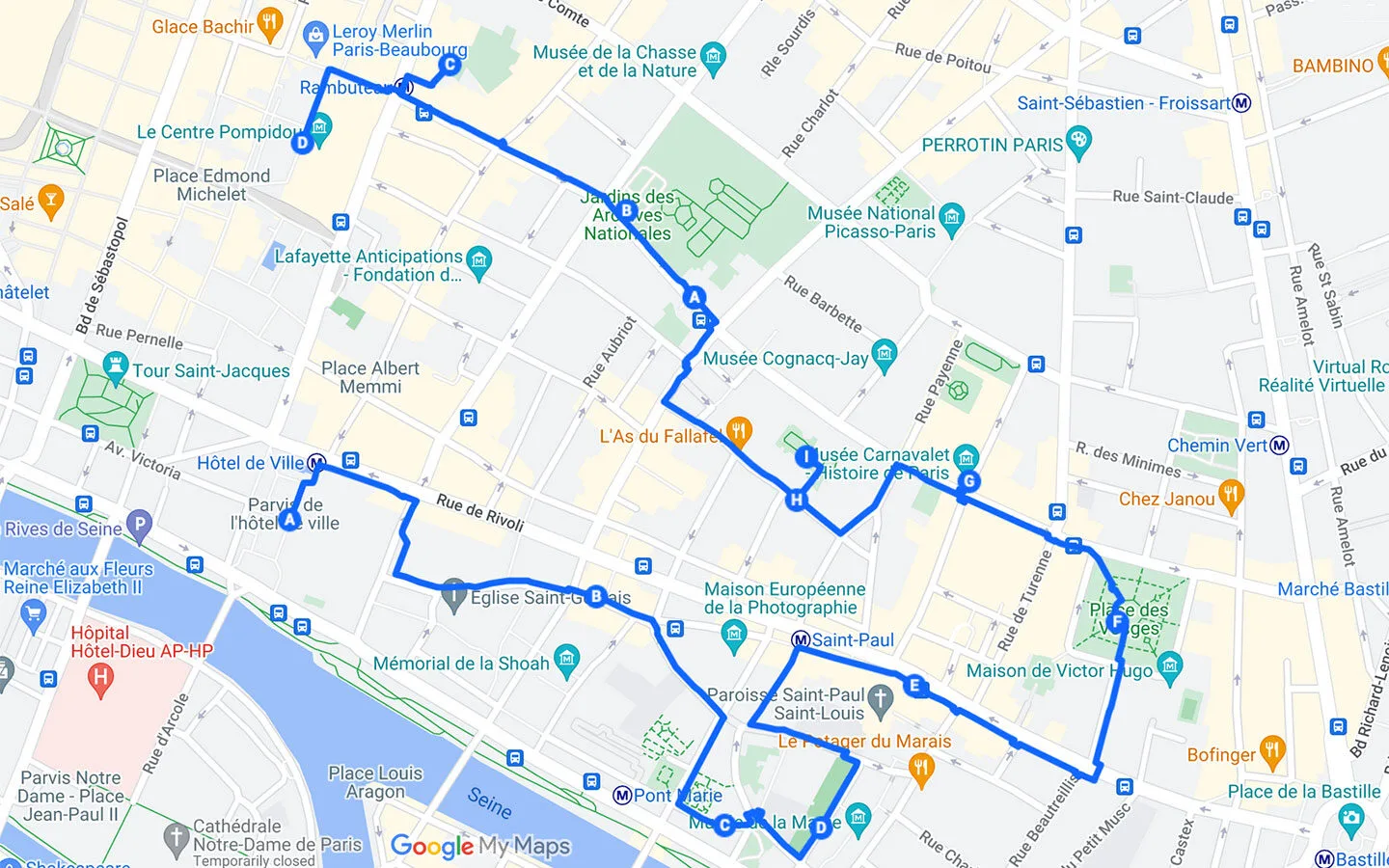
Save for later

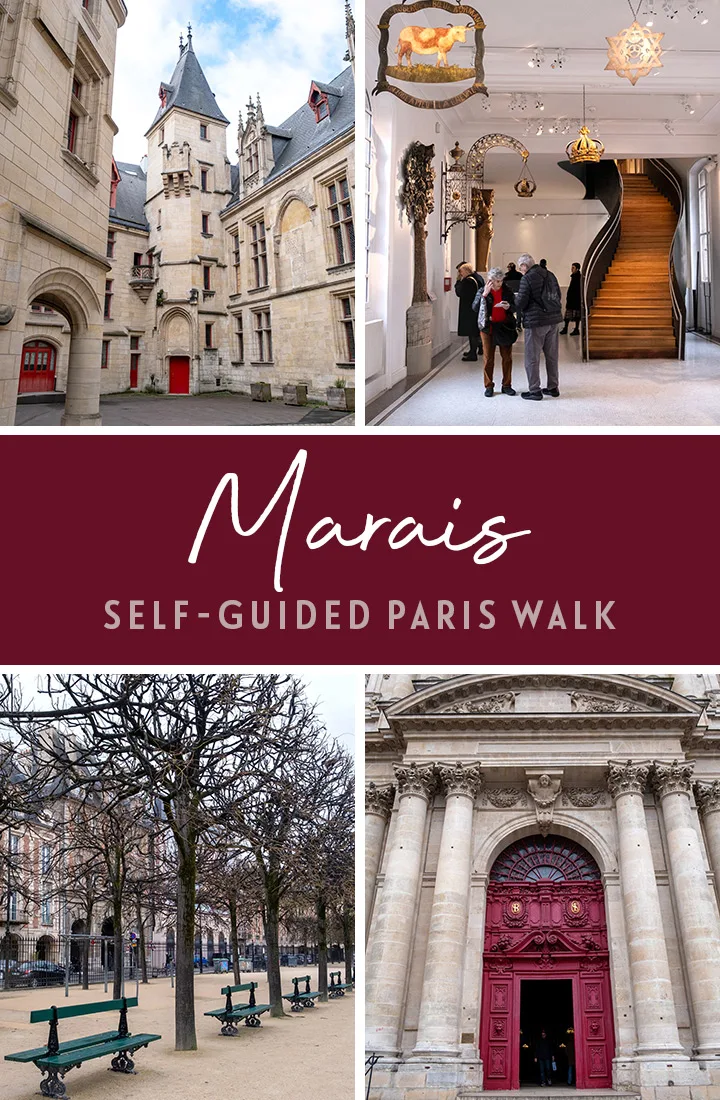

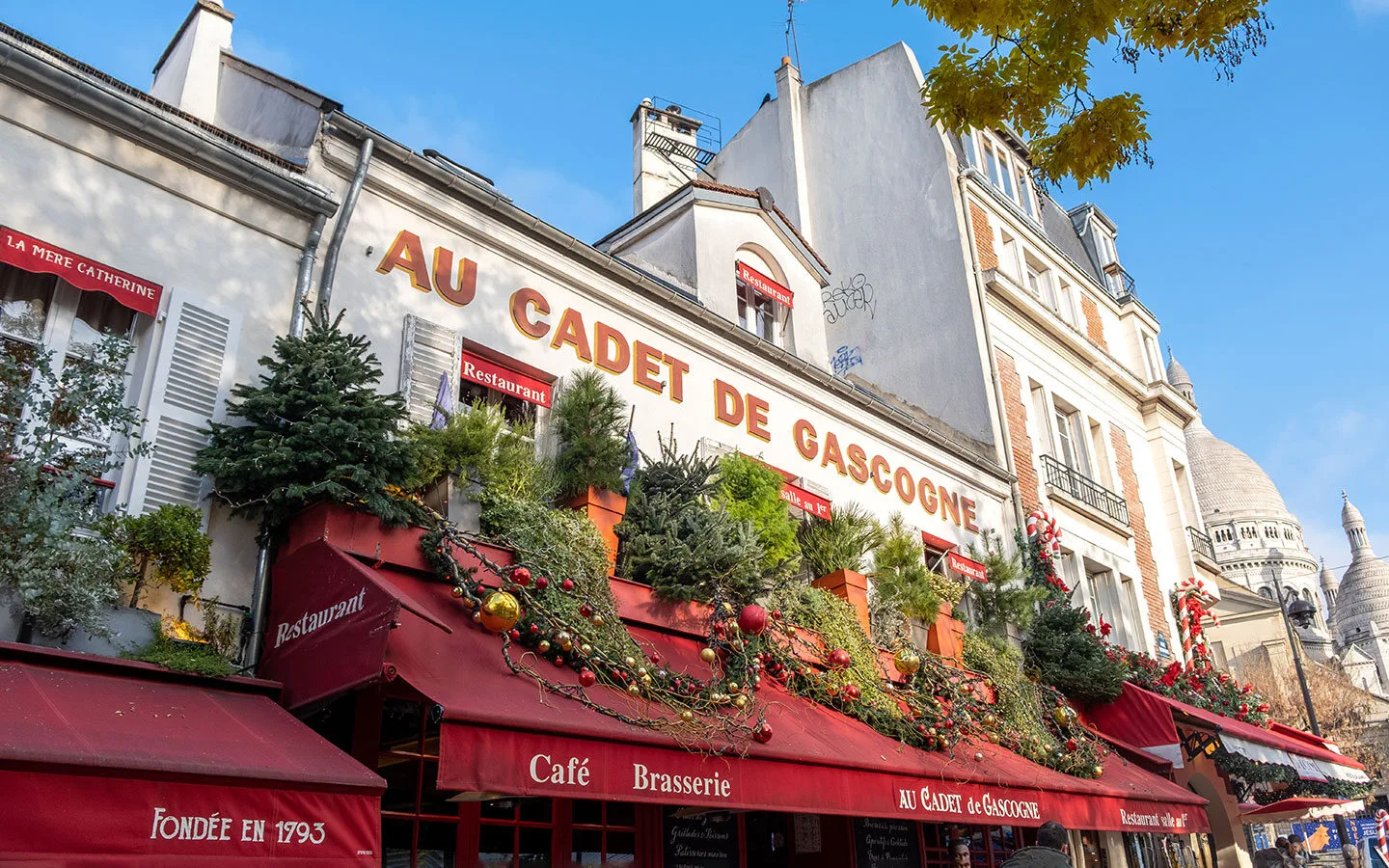
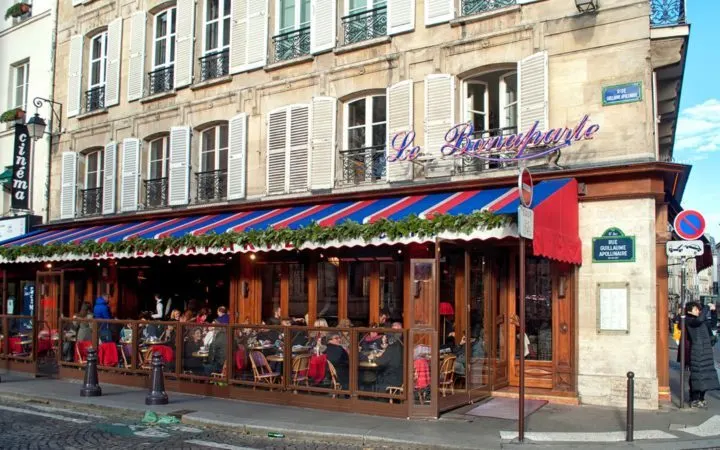
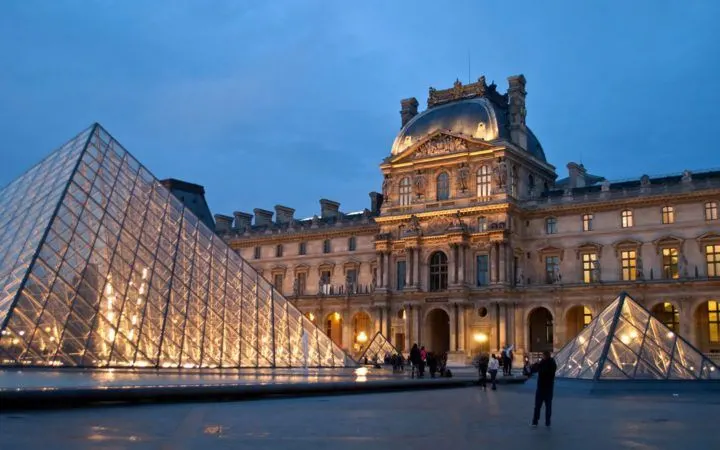
Johanna Bradley
Tuesday 20th of February 2024
I can tell I missed some interesting things in the Marais from reading your guide, Lucy. If I ever go back...
Lucy Dodsworth
Monday 26th of February 2024
Thanks Jo, and hopefully one day!